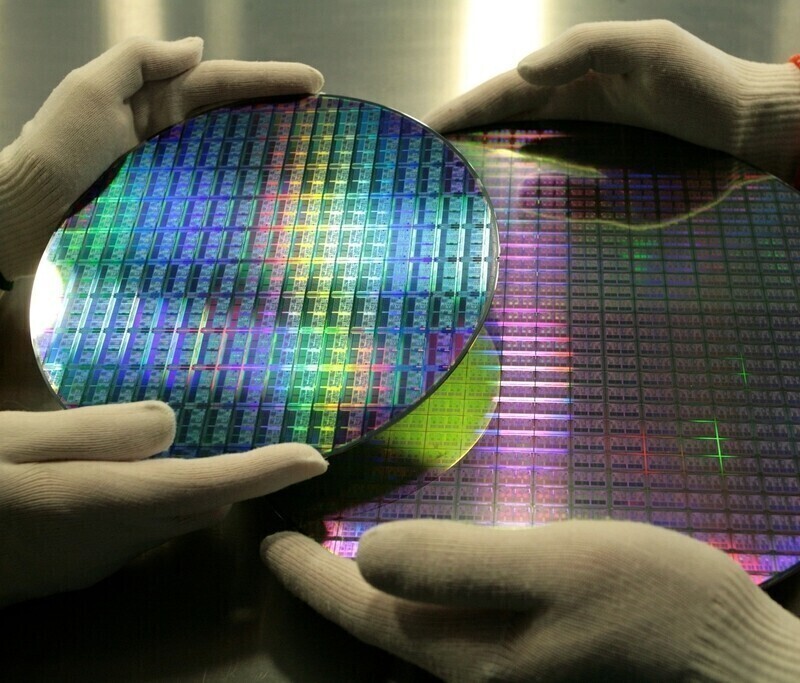hankyoreh
Links to other country sites 다른 나라 사이트 링크
Samsung vows no “artificial” chip cutbacks

Samsung Electronics is sticking to its approach of no artificial cutbacks to memory semiconductor production, even as its profitability has worsened amid an ongoing decline in demand.
The decision was made by Chairperson Lee Jae-yong during a recent workshop with members of the semiconductor sector leadership, including Kyung Kye-hyun, the president and CEO of Samsung’s device solutions division.
Samsung Electronics explained Sunday that the workshop at the company’s head office in Seoul’s Seocho area was held on March 20 by Lee, Kyung, and memory business chief Lee Jung-bae, among others.
According to sources, some within the sector called for production cutbacks, but Lee indicated that he had no plans to introduce them.
At the same time, the strong likelihood of another workshop being held ahead of the investor relations meeting in early April — where provisional first quarter figures are set to be announced — leaves open the possibility for a shift in the company’s position against artificial cutbacks.
So far in 2023, Samsung Electronics has introduced natural and technologically based production cutbacks due to a shift in processes.
Market conditions have worsened further this year for memory semiconductors, which suffered a drop in growth starting in the second half of 2022. The market’s second- and third-ranked companies, SK Hynix and Micron Technology, began introducing investment and production cutbacks last year in order to reduce losses and hasten a market rebound.
In contrast, Samsung Electronics considered artificial cutbacks at a January workshop but opted not to go ahead with them — a policy approach that it stuck to in its February and March workshops.
Performance has been deteriorating. With the end of the first quarter approaching, projections for Samsung Electronics and SK Hynix have dipped even further.
On Monday, FnGuide projected Samsung Electronics’ first-quarter operating profits at just 1.5 trillion won, while estimating SK Hynix’s operating losses at 3.5 trillion won. Compared with predictions a month earlier, Samsung Electronics’ operating profit forecast was around 1 trillion won lower and SK Hynix’s operating losses roughly 1 trillion won higher.
Collectively, the Samsung Electronics and SK Hynix DRAM and NAND flash inventories have been estimated at critical levels, with Shinhan Securities calculating them at over 15 weeks’ worth — far above the normal level of 3.5 weeks.
Samsung Electronics’ decision to oppose production cutbacks in spite of this is being interpreted as a move to sustain competitiveness and hold off later-starting rivals, even if it means swallowing losses.
Shinyoung Securities predicted that the losses for Samsung Electronics’ semiconductor would continue during the year, estimating them at around 4.1 trillion won in the first quarter, 3.2 trillion won in the second, and 100 billion won in the third. If the company sticks to its “no cutbacks” approach, the deficit could persist even longer.
For SK Hynix, the crisis is even more immediate. The company has been recording operating losses since the last quarter of 2022, and a return to positive figures will remain an even more distant prospect if Samsung Electronics does not join in the production cutbacks.
The result could be a replay of the “chicken” game that unfolded among semiconductor companies in the ’00s — stoking fears of the same sorts of pay and staff cuts.
Also, while Samsung Electronics has other revenue coming in through its smartphones, appliances, and other areas, SK Hynix has relied exclusively on semiconductor sales, which leaves it more vulnerable to market conditions.
“If Samsung Electronics doesn’t cut back production, that will mean an even bigger negative impact on the No. 2 and No. 3 companies SK Hynix and Micron,” said Kyung Hee-kwon, an associate research fellow at the Korea Institute for Industrial Economics and Trade.
“Since Micron at least has robust funding sources, SK Hynix could suffer the worst of it,” he predicted.
By Lee Jeong-hun, staff reporter
Please direct questions or comments to [english@hani.co.kr]

Editorial・opinion
![[Guest essay] Amending the Constitution is Yoon’s key to leaving office in public’s good graces [Guest essay] Amending the Constitution is Yoon’s key to leaving office in public’s good graces](https://flexible.img.hani.co.kr/flexible/normal/500/300/imgdb/original/2024/0416/8917132552387962.jpg) [Guest essay] Amending the Constitution is Yoon’s key to leaving office in public’s good graces
[Guest essay] Amending the Constitution is Yoon’s key to leaving office in public’s good graces![[Editorial] 10 years on, lessons of Sewol tragedy must never be forgotten [Editorial] 10 years on, lessons of Sewol tragedy must never be forgotten](https://flexible.img.hani.co.kr/flexible/normal/500/300/imgdb/original/2024/0416/8317132536568958.jpg) [Editorial] 10 years on, lessons of Sewol tragedy must never be forgotten
[Editorial] 10 years on, lessons of Sewol tragedy must never be forgotten- [Column] A death blow to Korea’s prosecutor politics
- [Correspondent’s column] The US and the end of Japanese pacifism
- [Guest essay] How Korea turned its trainee doctors into monsters
- [Guest essay] As someone who helped forge Seoul-Moscow ties, their status today troubles me
- [Editorial] Koreans sent a loud and clear message to Yoon
- [Column] In Korea’s midterm elections, it’s time for accountability
- [Guest essay] At only 26, I’ve seen 4 wars in my home of Gaza
- [Column] Syngman Rhee’s bloody legacy in Jeju
Most viewed articles
- 1[Guest essay] Amending the Constitution is Yoon’s key to leaving office in public’s good graces
- 2Faith the power of memory: Why these teens carry yellow ribbons for Sewol
- 3[Guest essay] How Korea turned its trainee doctors into monsters
- 4[Editorial] 10 years on, lessons of Sewol tragedy must never be forgotten
- 5US grants Samsung up to $6.4B in subsidies for its chip investments there
- 6[News analysis] Watershed augmentation of US-Japan alliance to put Korea’s diplomacy to the test
- 7How Samsung’s promises of cutting-edge tech won US semiconductor grants on par with TSMC
- 8Korea ranks among 10 countries going backward on coal power, report shows
- 9‘National emergency’: Why Korean voters handed 192 seats to opposition parties
- 10[Column] A death blow to Korea’s prosecutor politics